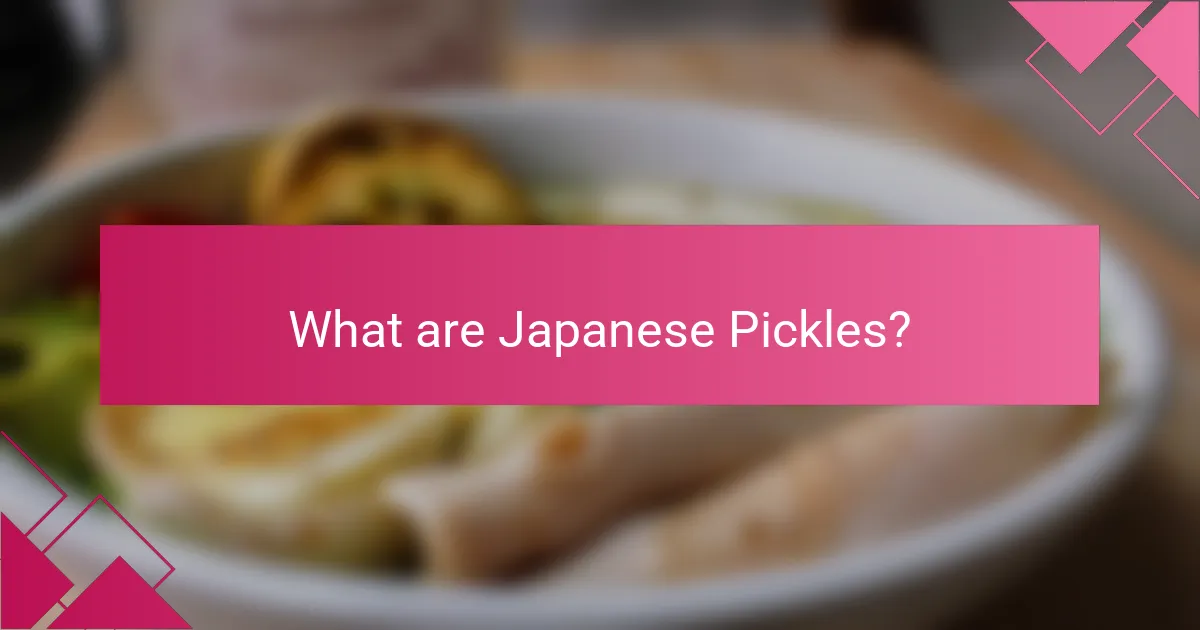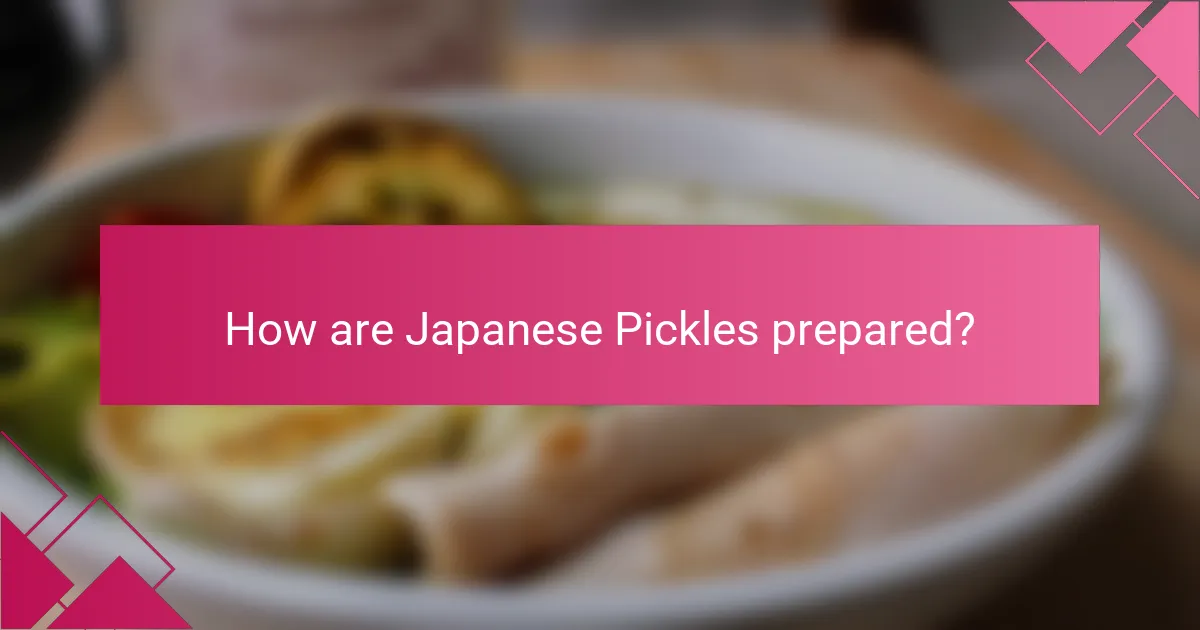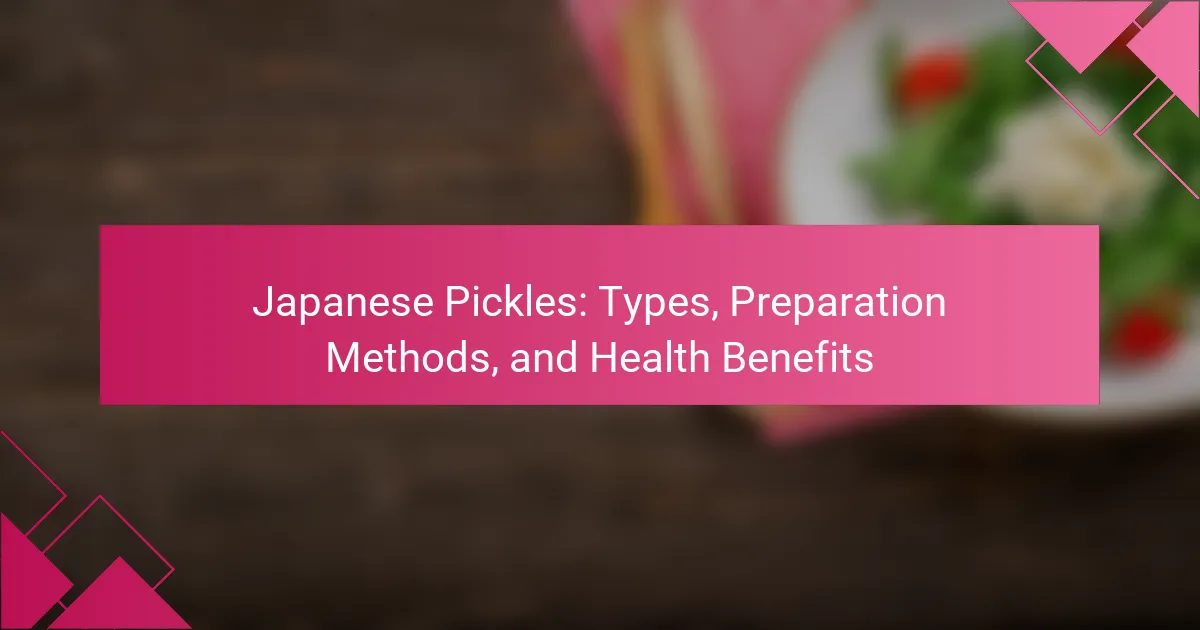
What are Japanese Pickles?
Japanese pickles are a traditional form of preserved vegetables in Japan. They are known as “tsukemono” in Japanese. Tsukemono can be made from various vegetables, including cucumbers, radishes, and eggplants. The preservation process often involves fermentation, salting, or pickling in vinegar. Each method imparts unique flavors and textures to the vegetables. Japanese pickles are commonly served as side dishes or garnishes. They also play a significant role in enhancing the overall taste of meals. Their rich history dates back centuries, reflecting Japan’s culinary culture.
How are Japanese Pickles categorized?
Japanese pickles are categorized into several types based on their preparation methods and ingredients. The primary categories include tsukemono, which are pickled vegetables, and nukazuke, which are fermented in rice bran. Other types include shoyuzuke, pickled in soy sauce, and misozuke, which are pickled in miso. Each category has distinct flavors and textures, influenced by the ingredients used. Tsukemono can be made from various vegetables like cucumbers, radishes, and eggplant. The fermentation process in nukazuke enhances the nutritional value of the vegetables. Shoyuzuke and misozuke provide umami flavors, making them popular in Japanese cuisine. These categories highlight the diversity of Japanese pickles and their cultural significance.
What are the different types of Japanese Pickles?
The different types of Japanese pickles include tsukemono, which are traditional pickled vegetables. Common varieties of tsukemono are umeboshi, pickled plums known for their sour flavor. Another type is takuan, pickled daikon radish that is sweet and crunchy. There is also shiozuke, which involves salting vegetables to create a simple pickle. Nukazuke is made by fermenting vegetables in rice bran. Lastly, there are asazuke, which are quick pickles typically made by soaking vegetables in vinegar and salt for a short period. Each type has distinct flavors and preparation methods, showcasing the diversity of Japanese pickling techniques.
What are the unique characteristics of each type?
Japanese pickles include various types, each with unique characteristics. Tsukemono are the most common, known for their vibrant colors and crunchy texture. They can be made from vegetables like cucumbers, radishes, and eggplants. Nukazuke, fermented in rice bran, have a distinct umami flavor and are often softer. Shiozuke are simply salted vegetables, retaining their original flavor while being preserved. Asazuke are quick-pickled, offering a fresh taste and crispness. Finally, kasuzuke involves marinating in sake lees, imparting a sweet and rich flavor. Each type showcases different ingredients and methods, contributing to the diversity of Japanese pickles.
What is the history of Japanese Pickles?
Japanese pickles, known as “tsukemono,” have a long and rich history. They date back to ancient times, around the 8th century. Initially, tsukemono were used as a preservation method for vegetables. The fermentation process allowed for longer storage and enhanced flavors. Over the centuries, various regional styles developed, influenced by local ingredients and climate. By the Edo period (1603-1868), tsukemono became a staple in Japanese cuisine. They were served with rice and other dishes to provide balance. Today, Japanese pickles are celebrated for their diverse flavors and health benefits. They remain a vital part of traditional meals and modern diets.
How have Japanese Pickles evolved over time?
Japanese pickles have evolved significantly over time. Initially, they were created for preservation and flavor enhancement. The earliest forms date back to the Jomon period, around 14,000 years ago. These early pickles were made using simple fermentation techniques. Over centuries, regional variations developed, influenced by local ingredients and climate. In the Edo period, the introduction of rice bran and salt led to new styles of pickling. Modern Japanese pickles, known as tsukemono, now include a variety of ingredients like vegetables and fruits. Today, they are enjoyed not only for their flavor but also for their health benefits. The evolution of Japanese pickles reflects changing culinary practices and cultural influences throughout history.
What cultural significance do Japanese Pickles hold in Japan?
Japanese pickles, known as “tsukemono,” hold significant cultural value in Japan. They are often served as side dishes in traditional meals. Tsukemono symbolize the changing seasons and the importance of seasonal ingredients. They also reflect the Japanese philosophy of food preservation and sustainability. Historically, these pickles were vital for preserving vegetables before refrigeration. They enhance flavors and provide balance to rice and other dishes. Additionally, tsukemono are integral to celebrations and rituals, showcasing regional diversity. Their preparation methods vary, highlighting local traditions and customs across Japan.
What are the health benefits of Japanese Pickles?
Japanese pickles offer several health benefits. They are rich in probiotics, which promote gut health. Probiotics support digestion and enhance the immune system. Japanese pickles also contain vitamins and minerals. These nutrients contribute to overall health and wellness. Additionally, they are low in calories, making them a healthy snack option. The fermentation process increases the bioavailability of nutrients. This means the body can absorb them more efficiently. Studies have shown that fermented foods can improve metabolic health.
How do Japanese Pickles contribute to digestive health?
Japanese pickles contribute to digestive health by providing beneficial probiotics. These probiotics are live microorganisms that support gut flora. Fermented Japanese pickles, such as tsukemono, undergo a fermentation process. This process enhances the growth of healthy bacteria. These bacteria help in breaking down food and improving nutrient absorption. Research shows that probiotics can alleviate digestive disorders. Studies indicate that regular consumption of fermented foods can improve gut health. Thus, Japanese pickles play a significant role in promoting digestive wellness.
What vitamins and minerals are found in Japanese Pickles?
Japanese pickles contain various vitamins and minerals. Common vitamins include vitamin A, vitamin C, and several B vitamins. Minerals found in Japanese pickles include potassium, calcium, and magnesium. The fermentation process enhances the nutritional content, making these pickles a source of probiotics as well. The specific types of vegetables used in pickling can affect the nutrient profile. For example, cucumbers provide hydration and vitamin K, while daikon radish contributes vitamin C and fiber. Overall, Japanese pickles are not only flavorful but also nutritionally beneficial.

How are Japanese Pickles prepared?
Japanese pickles are prepared through a process of salting, fermentation, or pickling in vinegar. The vegetables are first washed and cut into appropriate sizes. Salt is applied to draw out moisture and enhance flavor. Fermentation may occur in a brine solution or with the addition of koji mold. The duration of fermentation can vary from a few hours to several weeks, depending on the desired taste. Common ingredients include cucumbers, radishes, and eggplants. The final product is typically stored in jars and can be enjoyed as a side dish or condiment. This method preserves the vegetables while imparting unique flavors characteristic of Japanese cuisine.
What are the common preparation methods for Japanese Pickles?
Common preparation methods for Japanese pickles include salt fermentation, vinegar pickling, and rice bran pickling. Salt fermentation involves submerging vegetables in salt, allowing natural fermentation to occur. This method enhances flavor and preserves the vegetables. Vinegar pickling uses a mixture of vinegar, sugar, and salt to quickly pickle vegetables. This method produces a tangy flavor and is typically faster than fermentation. Rice bran pickling, known as nuka-zuke, involves coating vegetables in a mixture of rice bran, salt, and water. This method imparts a unique flavor and texture to the pickles. Each method has distinct characteristics that contribute to the diversity of Japanese pickles.
How is the fermentation process utilized in making Japanese Pickles?
Fermentation is a crucial process in making Japanese pickles. It involves the conversion of sugars into acids, gases, or alcohol by microorganisms. In Japanese pickling, lactic acid bacteria play a significant role. These bacteria are naturally present on vegetables and in the environment.
The process begins with fresh vegetables, which are often salted to draw out moisture. This salt creates an environment conducive to fermentation. As the vegetables sit, the lactic acid bacteria proliferate. They ferment the sugars in the vegetables, producing lactic acid.
This acid acts as a preservative and gives the pickles their tangy flavor. The fermentation duration can vary based on the type of pickle desired. For instance, quick pickles may ferment for a few hours, while traditional types can take days or weeks.
The resulting product is not only flavorful but also rich in probiotics. These beneficial bacteria contribute to gut health. Overall, fermentation enhances the taste and nutritional profile of Japanese pickles.
What role does salt play in the preparation of Japanese Pickles?
Salt is essential in the preparation of Japanese pickles. It acts as a preservative by inhibiting the growth of harmful bacteria. Salt also draws out moisture from the vegetables, creating a brine that enhances flavor. The process of osmosis allows the vegetables to absorb salt, which improves their texture. Additionally, salt aids in fermentation, promoting beneficial bacteria that contribute to the pickles’ unique taste. Historical practices show that salt has been used for centuries in Japanese pickling methods. This traditional technique ensures the longevity and quality of the pickles.
What ingredients are typically used in Japanese Pickling?
Japanese pickling typically uses ingredients such as salt, rice bran, vinegar, and sugar. Salt is essential for drawing out moisture and preserving vegetables. Rice bran is often used in traditional pickling methods like nuka-zuke. Vinegar adds acidity and enhances flavor in quick pickles. Sugar can be included to balance the sourness of vinegar. Other common ingredients include sake and mirin for added depth. These components work together to create the distinct flavors of Japanese pickles.
Which vegetables are most commonly pickled in Japan?
The most commonly pickled vegetables in Japan include cucumbers, daikon radish, and eggplant. Cucumbers are often pickled to create a refreshing side dish. Daikon radish is frequently used in various types of pickles, known as “tsukemono.” Eggplant is also popular for pickling, providing a unique flavor and texture. These vegetables are integral to Japanese cuisine and are enjoyed for their taste and preservation methods. Pickling enhances their flavors and extends their shelf life.
What additional flavoring agents are used in Japanese Pickles?
Japanese pickles often use additional flavoring agents such as soy sauce, mirin, and sake. These ingredients enhance the taste and complexity of the pickles. Other common flavoring agents include ginger, garlic, and chili peppers. Each of these ingredients contributes distinct flavors. For example, ginger adds a spicy warmth, while garlic provides depth. Moreover, the use of sesame seeds is also prevalent for added texture and nuttiness. The combination of these agents varies by region and recipe, showcasing the diversity of Japanese pickles.

How can you incorporate Japanese Pickles into your diet?
Incorporating Japanese pickles into your diet can enhance flavor and nutrition. You can serve them as a side dish with rice and protein. They also work well in salads, adding crunch and tang. Use them as a topping for sandwiches or wraps for extra zest. Another option is to include them in rice bowls or grain salads for a burst of flavor. Japanese pickles can also be blended into sauces or dressings for added complexity. They provide probiotics, which support gut health. Including a variety of pickles can offer different textures and tastes.
What are some popular dishes that feature Japanese Pickles?
Popular dishes that feature Japanese pickles include sushi, bento boxes, and rice dishes. Sushi often incorporates pickled vegetables for added flavor and texture. Bento boxes typically contain a variety of pickles alongside rice and protein. Rice dishes like ochazuke are enhanced with pickles, providing a salty contrast. Additionally, pickles are served as side dishes in many Japanese meals. They complement grilled fish and meat dishes well. Japanese pickles also appear in salads and as garnishes. Their distinct taste elevates the overall dining experience.
How can Japanese Pickles enhance the flavor of meals?
Japanese pickles enhance the flavor of meals by adding unique tanginess and crunch. They provide a balance to rich and savory dishes. The fermentation process in making pickles develops complex flavors. These flavors can complement various cuisines and ingredients. For instance, pickled daikon adds a refreshing contrast to fatty meats. Additionally, their vibrant colors can make dishes visually appealing. Japanese pickles also contribute probiotics, which can aid digestion. This can enhance the overall dining experience by promoting gut health.
What tips can help you make the best Japanese Pickles at home?
Use fresh vegetables for the best Japanese pickles. Select seasonal produce for optimal flavor and texture. Clean the vegetables thoroughly before pickling. Cut them into uniform sizes to ensure even pickling. Choose the right type of pickling solution, such as salt, vinegar, or soy sauce. Allow the pickles to marinate for the recommended time for full flavor development. Store pickles in a cool, dark place to maintain freshness. Taste test periodically to determine the desired flavor profile.
What common mistakes should you avoid when preparing Japanese Pickles?
Common mistakes to avoid when preparing Japanese pickles include using overly ripe vegetables. Overripe vegetables can lead to mushy textures and off-flavors. Another mistake is not salting the vegetables adequately. Proper salting draws out moisture and enhances flavor. Failing to use the right pickling solution is also crucial. Different vegetables require specific vinegar types for optimal taste. Ignoring fermentation time can ruin the pickles. Each type of pickle has a recommended fermentation duration for best results. Finally, not sterilizing jars can introduce harmful bacteria. Clean jars ensure the safety and longevity of the pickles.
How can you store Japanese Pickles for maximum freshness?
Store Japanese pickles in an airtight container to maintain freshness. This prevents exposure to air, which can lead to spoilage. Keep the container in a cool, dark place, ideally in the refrigerator. The cold temperature slows down the fermentation process. For long-term storage, consider freezing the pickles. Freezing preserves their texture and flavor for several months. Use glass or BPA-free plastic containers for best results. Ensure that the pickles are fully submerged in their brine to avoid drying out. These methods help retain the quality and taste of Japanese pickles over time.
Japanese pickles, known as “tsukemono,” are a traditional form of preserved vegetables in Japan, made through various methods such as fermentation, salting, and vinegar pickling. This article covers the different types of Japanese pickles, including tsukemono, nukazuke, shoyuzuke, and misozuke, highlighting their unique characteristics and preparation methods. It also explores the historical significance of pickles in Japanese cuisine, their health benefits, particularly for digestive health, and tips for making and storing them at home. Overall, Japanese pickles play an essential role in enhancing flavors and providing nutritional value in meals.
